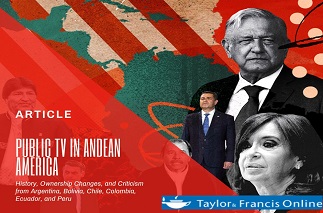Posts

Apomediation and Disintermediation: YouTube Prescribers on Fad Diets
As a result of the confinements of the COVID-19 pandemic and the sedentary lifestyle due to teleworking, there is an increase in weight gain and dietary carelessness in the population, which leads to an increase in offers of fad diets based on recommendations made by digital influencers. The aim of the study was to examine the characteristics of dietary recommendation videos made by non-health professional prescribers in Spanish and English to understand what patterns are followed by the productions of this type of content and what effects they have on the interaction they receive. An exploratory walkthrough method analysis was applied to define the variables of a codebook, followed by a content analysis of a sample of 50 videos published between January 2020 and July 2021. Most of the videos are published in the first months of the year, probably aimed at users seeking to reduce the weight gained during Christmas. The productions were characterized by having a very personal tone, informative and with relatively plural information, sometimes addressing the risks of diets or slimming products, and, although recommendations abound, the voices of experts are not frequent. The products and diets addressed in the videos often have a high health risk and do not involve practices recommended by experts, so although sometimes their contraindications or associated risks are pointed out, the promotional component and the search for traffic to the channel seem to be more relevant factors than public health in these videos.

Patterns and Actors of Disinformation: Analysis of Debunked Hoaxes in Spain in 2022
This research examines the patterns followed by disinformation in Spain through the fact-checking activities of Maldita.es, the leading fact-checking organization in Spain. We sought to answer three research questions: 1. What are the predominant topics of the hoaxes debunked by Maldita.es? 2. Who is responsible for the creation and dissemination of these hoaxes? and 3. In what formats and platforms are these hoaxes generally distributed? For this purpose, we conducted a quantitative content analysis of 729 hoaxes fact-checked in 2022 by Maldito Bulo. 40.7% of the debunked hoaxes were related to social issues, while 37.2% focused on political affairs. Regarding those responsible for the creation and dissemination, most of the hoaxes came from unidentified sources, although when the identity is known, the most frequent contributors are social media accounts, alternative and partisan pseudo-media, and journalists. These results explore the general disinformation scenario in Spain, using fact-checking as an approximation and discussing its implications.

Populist attitudes and perceptions of public opinion and the media: A comparative correlational study between Spain and Colombia
Populism has experienced a worrying growth in the last decade in different locations around the world. This globalizing process has been enhanced by the immediacy, interaction, and participation of social networks, cyber media, and other digital platforms. In this context, the perception that young people give to this type of phenomena constitutes a field of study of great interest for the Social Sciences. This research examines the correlations between populist attitudes, perception of public opinion, and opinions about the media in students of Communication Sciences in Colombia and Spain. Methods: Based on an exploratory-correlational approach and a quantitative design, this research has analyzed the reflections and priorities of a group of n=499 undergraduate and graduate students related to Communication Sciences in Colombia and Spain. Results: The study has confirmed the leading role played by social networks in the formation of radical opinions while detecting a decline in the influence of television among young audiences. In addition, the study establishes that the index of public opinion perception is higher in Spain, while the index of media perception or anti-elitist attitudes is higher in Colombia, and there is no clear link between populist attitudes and a political ideology of extremes. Conclusions: The correlations examined note a tendency towards disaffection and discredit towards politics in general, especially by the young population, which affects actors and institutions. It alludes to the preference of this population group for interacting and informing themselves on digital platforms and presents populist attitudes, without clear ideological identification, but with a clear tendency towards simplification of messages, thus emphasizing the need to educate the critical view of citizens and to work on media literacy as a crucial strategy against the growth and expansion of populism.

Symbolic-discursive violence and new media: An epistemological perspective
The following research studies, from a theoretical perspective, the different forms of symbolic and discursive violence and the transmission of hate speech through new media. The main objective is to understand the consequences of symbolic violence through language and how this affects freedom of expression. Reflective and critical argumentation is highlighted through an exploratory analysis carried out by a literature review, where it is determined that the confrontational narrative used by the media contributes to the dehumanization, demonization and polarization of specific collectives.

The «ventriloquist effect» of the international news agencies. Theoretical review and incidence on new forms of misinformation
This research reflects, from a theoretical perspective, how most of the international events that reach the rest of the media are disseminated through news agencies, causing the well-known «ventriloquist effect»: multiple media, a single voice; and explores how online platforms have fostered this phenomenon, causing a structural increase in misinformation. In this sense, the research aims to understand the development of the «ventriloquist effect» with the progress of «new media» and, as a consequence, the increase of disinformation. For this grounded theory documentary analysis, the methodological procedure was based on the bibliographic review of the literature in the international reference databases (WoS and Scopus), carrying out an analysis of primary studies to synthesize the information. The results indicate, among other issues, that social networks foster spaces of structural misinformation in the current ecosystem. In conclusion, the relationship between the "ventriloquist effect" and misinformation, which arises from reticularly and information-digital decentralization, is determined.

How to Botox’ on YouTube: Influence and Beauty Procedures in the Era of User-Generated Content
The current media environment is complex and has important effects on all aspects of life, including beauty and health. In this sense, YouTube has become one of the main contexts for the dissemination of tutorials and content related to medical procedures such as the application of Botox. Thus, the present study constitutes the first exploratory analysis of YouTube videos in Spanish related to this procedure. A preliminary analysis of 221 YouTube videos yielded a final sample of the 50 most viewed videos within this genre. The analysis was carried out through a quantitative content analysis assessing the popularity of the videos, contact and emotive strategies by the creator, the credibility conveyed, and the characteristics of information about the procedure itself. Results suggest that these influencers align with mainstream Internet celebrity culture in practices that aim at increasing their following and views, as well as calls for subscriptions and visits to other platforms and profiles. Moreover, they include different strategies to establish their credibility but emphasize personal experience. The positive portrayal of the procedure, including positive emotions and content that highlights the benefits, is interesting and supports the commercial nature of much of the content.

Public Television In Andean America: History, Ownership Changes, and Criticism From Argentina, Bolivia, Chile, Colombia, Ecuador, and Peru
This paper analyzes and describes public television in Andean America through the historical, hermeneutic, and non-participating observation method, carrying out a critical review of the literature, legal provisions, and official websites. The research reveals the appearance and precariousness of Andean-American public television, its financing, and particular administration forms. Twenty-four stations were identified as having evidence of public ownership, of which only eight are close to the principle of public service TV. There is little evidence of the existence of public service television because of the political-ideological control of the public media by the various governments, especially by populist regimes. Also, public television in the Andean region suffers from the cultural contamination of banal commercial content and infotainment.

Construction of War Discourse on International News Agencies: Case Study Terrorist attacks November 13th 2015
This study analyzes warmongering rhetoric presented by international agencies Reuters, Al Arabiya, Al Jazeera and Associated Press (AP) of the information related to the terrorist attacks in Paris on November 13th, 2015 for 15 days after the event. We have started from a quantitative and qualitative analysis of 550 information units using the software MAXQDA (v. 11.0.11). Subsequently, the semantic criteria of media discourse: functionality, significance and direction of the goal was applied on the selected sample. The results demonstrate the prevailing demonization of Islam, the exaltation of fear and panic in the discursive construction and it highlighted the spectacle of the information as a communicative strategy on the rhetorical guidance.

The economic disinformation in Spain: case study of BFA-Bankia and its IPO
The research this article is inscribed on comes from the belief that the current characteristics of the communications ecosystem generate the conditions for the occurrence of disinformation ploys due to informational insufficiency and partial information, abuse of fidelity to the source, the absence of interpretive and investigative journalism, and the incomprehensibility of the information. The main objective is to determine the relationship between the journalistic handling of information as the creator of socialized realities and dis-information, from the semantic analysis and interpretation of content based on the digital editions of 3 Spanish printed media of daily rotation (El País, ABC, and El Mundo), in retrospective to the listing in the stock market of BFA-Bankia (6th to 20th July 2011) and prospectively on the interval after ten consecutive days of losses (3rd to 17th May 2012). The main results show endogenous journalistic disinformation or poor handling of the financial information made public through the analyzed media existed due to the creation of positive expectations of the re-evaluation of the financial holding on the stock market. Meanwhile, the lack of investigative journalism, fidelity to official sources, and the language used in financial reporting in the media outlets mentioned above also contributed to the favorable scenario for disinformation.
